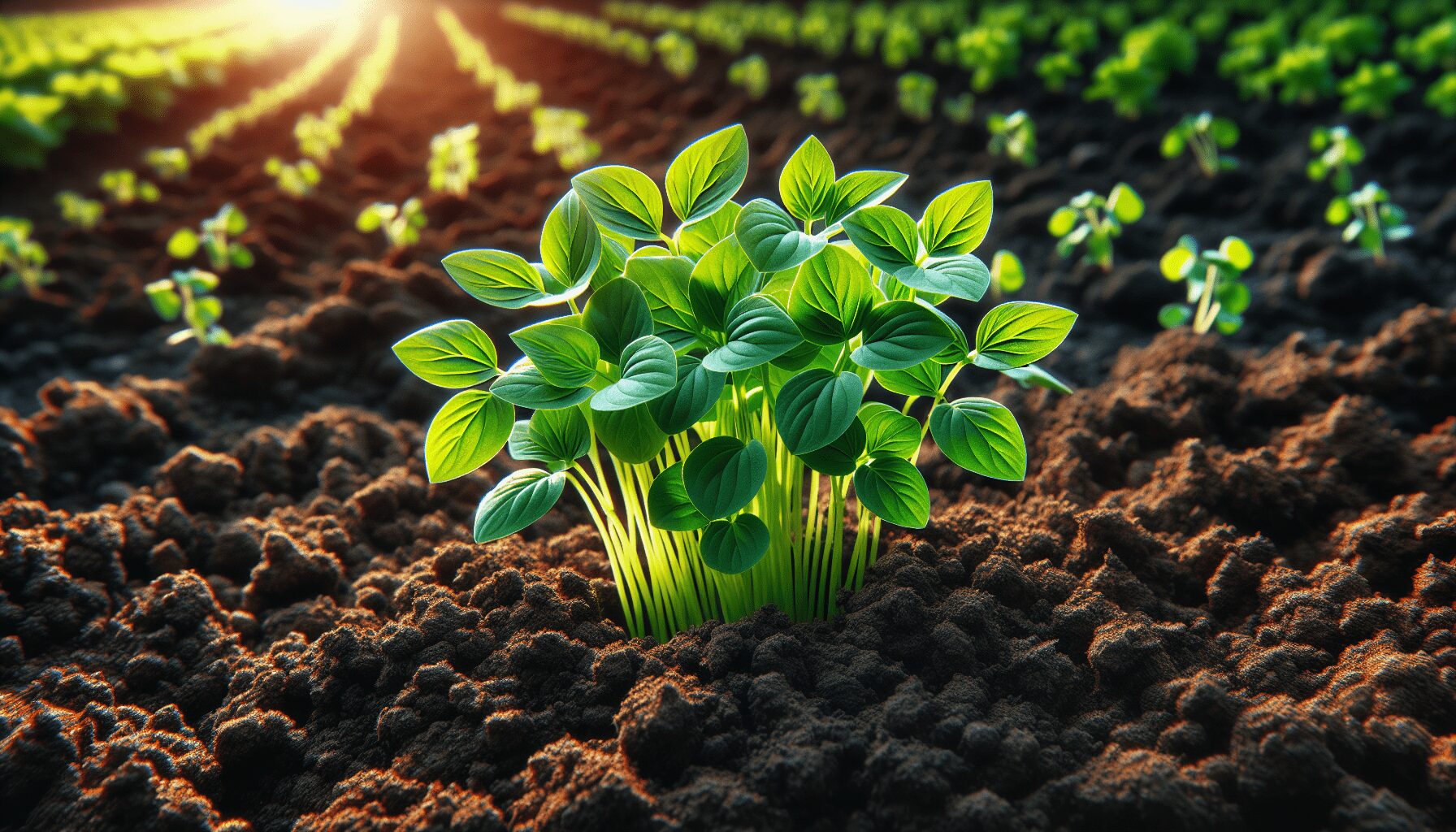In “Green Manuring: Overcoming Heavy Clay Soil with Buckwheat | Homestead Vlog,” you’ll learn how to transform your stubborn clay soil into rich, plant-friendly terrain. Hosted by The Acadian Garden & Apothecary, this vlog showcases the power of buckwheat as a game-changer in soil improvement, perfect for both seasoned gardeners and beginners. Buckwheat is not only quick to grow and easy to manage, but it’s also packed with benefits like moisture retention, weed suppression, and nutrient enhancement.
Imagine turning your heavy, compact soil into a fertile ground for healthy vegetables, all without breaking the bank. This video takes you through practical steps and shares firsthand experiences in using buckwheat as a cover crop and green manure. Whether you prefer traditional tilling or no-dig methods, you’ll find actionable tips to make your gardening journey more productive and enjoyable.

This image is property of i.ytimg.com.
Understanding Green Manuring
Definition and Purpose
Green manuring is a gardening technique where you grow certain crops specifically to improve soil health. You don’t harvest these crops for food; instead, you incorporate them back into the soil. It’s like nature’s own composting system. When you grow green manure crops, they add organic matter to the soil, improve soil structure, and increase nutrient availability. The idea is to grow something that benefits the ground rather than your plate, making it a win-win for the soil and future crops.
Benefits for Soil Health
Green manuring can be a total game-changer for your garden’s soil health. By growing plants specifically for this purpose, you introduce organic matter and vital nutrients into the soil. Think of it as giving your garden a vitamin boost. The decomposition of these crops creates humus, which can retain water, aerate the soil, and foster beneficial microbial activity. All these factors contribute to healthier, more resilient plants in the future.
Common Green Manure Crops
Several crops are commonly used for green manuring. Favorites include legumes like peas and beans, which add nitrogen to the soil, and grasses like rye, which help prevent erosion. Mustard and clover are also popular choices. Each has its own set of superpowers, so you can choose the one that best fits your garden’s needs.
Challenges of Heavy Clay Soil
Characteristics of Clay Soil
Clay soil has its unique set of characteristics. It’s dense, it’s sticky when wet and rock-hard when dry. It doesn’t drain well, leading to puddling and poor root development. While it holds nutrients better than sandy soil, it can be tough to work with. If you’ve ever tried to shovel wet clay, you know exactly what I mean!
Problems Faced by Homesteaders
For homesteaders, clay soil presents quite a few challenges. Poor drainage and compaction can lead to root rot and stunted plant growth. It’s also difficult to till and can become easily waterlogged. Establishing a productive garden in heavy clay can feel like an uphill battle, especially if you’re aiming for larger-scale farming rather than just a few raised beds.
Traditional Solutions for Clay Soil
Traditional solutions often involve labor-intensive methods like double digging or adding copious amounts of organic material like compost and manure. Mulching and building raised beds can also help but require substantial upfront work and materials. Some gardeners opt for gypsum to help break down the clay, but it’s not a quick fix.
Why Buckwheat is an Ideal Green Manure
Characteristics of Buckwheat
Despite its name, buckwheat is not related to wheat. It’s a fast-growing, broadleaf plant that thrives even in poor, compacted soils. It doesn’t require a lot of fuss, which makes it an ideal candidate for green manuring. It flowers quickly, within 4 to 6 weeks, providing a fast turn-around time for soil improvement.
How Buckwheat Improves Soil
Buckwheat’s root system helps break up heavy clay soil, improving its structure and aeration. Plus, it scavenges phosphorus from deep in the soil, making it more available for future plants. It also decomposes quickly, adding plenty of organic matter back into the ground. Additionally, buckwheat suppresses weeds, giving you a cleaner slate for planting your next crop.
Benefits of Using Buckwheat Over Other Crops
Compared to other green manures, buckwheat is quick and easy. It doesn’t require a lot of water or fertile soil, making it perfect for rough conditions. Plus, it attracts pollinators like bees, which is always a bonus. Its ability to grow rapidly and its efficiency in weed suppression gives it a leg up over crops like rye or clover.
Planting Buckwheat for Green Manuring
Best Planting Time
Buckwheat is versatile but thrives best during the warmer months. You can plant it in late spring to early summer, once the danger of frost has passed. It loves the sun and can handle a variety of soil conditions, so just go ahead and broadcast those seeds when the weather is warm and the soil is workable.
Seed Selection and Preparation
Selecting good quality buckwheat seeds is crucial. Try to go for untreated, organic seeds to keep things eco-friendly. Before planting, prepare the soil by lightly tilling or raking it to ensure good seed-to-soil contact. There’s no need for heavy fertilization; buckwheat will do just fine on its own.
Optimal Planting Techniques
For best results, sow the seeds fairly densely, aiming for about 60 to 80 pounds per acre. You can scatter the seeds by hand or use a broadcast spreader for larger areas. After sowing, lightly drag a rake over the soil or use a roller to press the seeds into the ground. Water them in well, and you’re good to go!

Managing Buckwheat Growth
Monitoring Growth Stages
Once planted, keep an eye on your buckwheat. It grows fast, so you’ll notice it sprouting within a week or so. After about 4 to 6 weeks, it’ll start to bloom. This is your cue that it’s getting close to the point where you’ll want to think about incorporation.
Watering and Nutrition Needs
Buckwheat is pretty low-maintenance when it comes to water. If you’re in a dry spell, give it a good soak now and then. Otherwise, regular rainfall should be sufficient. It doesn’t need much in terms of extra nutrients either, making your job that much easier.
Identifying and Managing Pests
Although relatively pest-resistant, keep an eye out for aphids and flea beetles. If you do spot pests, a simple insecticidal soap or neem oil spray can help keep them in check. Buckwheat’s rapid growth usually outpaces most pest problems, but a little vigilance goes a long way.
Incorporating Buckwheat into the Soil
When to Incorporate
Timing is crucial for incorporating buckwheat. Aim to turn it into the soil just as it starts to flower. If you wait too long, it’ll go to seed and might become a weed problem later.
Best Techniques for Incorporation
You can incorporate buckwheat using a tiller or by simply chopping it down with a hoe and turning it over with a shovel. For no-dig enthusiasts, you can lay it down as a mulch and let it decompose naturally. Either way, the goal is to mix the plant material into the top few inches of soil.
Tools and Equipment Needed
For larger plots, a rototiller is your best friend. For smaller gardens, a sturdy hoe or spade will do the trick. You might also need a rake to smooth things out afterward, but nothing too fancy is required.

Benefits Observed Post-Incorporation
Soil Structure Improvements
After incorporating buckwheat, you’ll notice the soil becoming less compacted and more crumbly. The root systems of the decayed plants improve aeration and drainage, making it easier for new plants to establish strong root systems.
Enhanced Nutrient Availability
As buckwheat decomposes, it releases much-needed nutrients back into the soil. This creates a mini-ecosystem where microorganisms thrive, further enhancing nutrient availability and uptake for the next round of crops you plant.
Increased Soil Microbial Activity
Adding organic matter from buckwheat boosts microbial activity in the soil. These microbes are like tiny gardeners, working tirelessly to improve soil health. You’ll find that your soil becomes more vibrant and productive over time.
Comparing Buckwheat with Other Green Manure Crops
Buckwheat vs. Legumes
While legumes are great for nitrogen fixation, they take longer to grow and often need specific soil conditions. Buckwheat, on the other hand, is faster and less picky.
Buckwheat vs. Mustard
Mustard is excellent for breaking down soil pathogens, but it can be a bit more challenging to manage. Buckwheat is simpler and doesn’t have the pungent smell that mustard sometimes brings.
Buckwheat vs. Rye
Rye is fantastic for preventing erosion and adding organic matter, but it grows slower compared to buckwheat. Buckwheat’s rapid growth cycle allows you to fit multiple plantings in a single season, making it super-efficient.
Real-Life Success Stories
Case Study 1: A Small Scale Farm
On a small-scale farm in Pennsylvania, buckwheat was used to rejuvenate tired, over-farmed soil. Within a single season, the farm saw a significant improvement in soil texture and water retention, leading to healthier crops and better yields.
Case Study 2: A Community Garden
A community garden in urban Chicago implemented buckwheat as a green manure to improve the clay-heavy soil. The results were astonishing—less compaction, fewer weeds, and a more vibrant garden overall. Gardeners reported that vegetables like tomatoes and peppers grew more robustly than ever before.
Case Study 3: A Personal Homestead
On a personal homestead in Maine, buckwheat transformed a previously unproductive plot into a fertile garden space. Over two years, with multiple buckwheat plantings, the soil became rich, dark, and full of life, supporting an expansive vegetable garden that feeds the family year-round.
Conclusion
Summary of Benefits
Using buckwheat as green manure can significantly improve your soil health. It breaks up heavy clay, adds organic matter, enhances nutrient availability, and fosters beneficial microbial activity. Quick-growing and easy to manage, it’s a fantastic choice for any gardener looking to improve their soil quickly and efficiently.
Encouragement to Try Buckwheat
Why not give it a shot? Whether you’re working in a small backyard garden or trying to manage a larger farm, buckwheat can make a noticeable difference. It’s low-maintenance, high-reward, and beneficial for the ecosystem.
Final Thoughts
Buckwheat isn’t just a versatile food crop; it’s a soil superhero. If you’re struggling with heavy clay soil or just looking to give your garden an organic boost, buckwheat has got you covered. Try it out, and watch as your soil transforms into a thriving, fertile ground. Happy gardening!